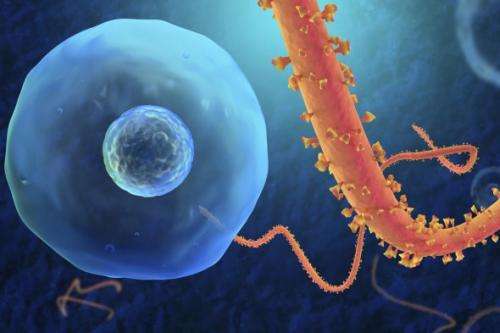Attack Ebola on a nanoscale

(Phys.org) —The Ebola virus outbreak in West Africa has claimed more than 900 lives since February and has infected thousands more. Countries such as Nigeria and Liberia have declared health emergencies, while the World Health Organization began a two-day meeting on Wednesday to discuss ways to battle the outbreak.
There is no known vaccine, treatment, or cure for Ebola, which is contracted through the bodily fluids of an infected person or animal. But that doesn't mean there's not hope. In fact, Chemical Engineering Chair Thomas Webster's lab is currently working on one possible solution for fighting Ebola and other deadly viruses: nanotechnology.
"It has been very hard to develop a vaccine or treatment for Ebola or similar viruses because they mutate so quickly," explained Webster, the editor-in-chief of the International Journal of Nanomedicine. "In nanotechnology we turned our attention to developing nanoparticles that could be attached chemically to the viruses and stop them from spreading."
One particle that is showing great promise is gold. According to Webster, gold nanoparticles are currently being used to treat cancer. Infrared waves, he explained, heat up the gold nanoparticles, which, in turn, attack and destroy everything from viruses to cancer cells, but not healthy cells.
Recognizing that a larger surface area would lead to a quicker heat-up time, Webster's team created gold nanostars. "The star has a lot more surface area, so it can heat up much faster than a sphere can," Webster said. "And that greater surface area allows it to attack more viruses once they absorb to the particles." The problem the researchers face, however, is making sure the hot gold nanoparticles attack the virus or cancer cells rather than the healthy cells.
In addition to the gold nanostars, Webster's lab is also generating a nanoparticle that would serve as a "virus decoy," chemically attracting the virus to attack it rather than healthy cells.
While Webster's lab has been working in nanotechnology for about 15 years, it was not until recently that his lab started to explore the benefits of nanomedicine.
"We realized the potential," Webster said, noting that his student researchers use synthetic analogs that mimic viruses' structures. "There is obviously such a huge need right now for ways to treat Ebola and other viruses, and it's up to us to study and look at new and creative ways that traditional medicine really can't."
Provided by Northeastern University

















